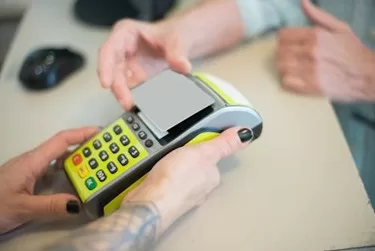Understanding Contactless Payments :
Contactless payments are a way to pay for goods or services without physically touching the payment terminal or handing over your card. Instead of swiping or inserting your card into a machine, you simply hold it near a contactless-enabled terminal, and the payment is processed automatically. Speed is key in today's fast-paced world, and contactless payments deliver. The entire transaction takes just a few seconds, allowing you to reduce time spent in checkout lines even during the busiest times.
By eliminating the need for physical contact with payment terminals or cashiers, contactless payments also maintain hygiene and help reduce the spread of germs and bacteria. They are also incredibly secure. Each transaction is encrypted, and contactless cards use dynamic authentication methods, making them much harder to counterfeit or clone compared to traditional magnetic stripe cards.
Contactless payments aren't just limited to cards. Latest smartphones now come equipped with built-in NFC (Near Field Communication) technology, allowing you to make payments with just a tap of your device. This versatility makes contactless payments accessible to a wide range of consumers.

RFID in Contactless payment systems
Components of a Contactless Payment System :
- Contactless Payment Card or Device : This is the physical card or device (such as a smartphone) that holds the necessary payment information and is used to initiate the transaction. Contactless payment cards typically contain an RFID chip and antenna, while devices may use technologies like Near Field Communication (NFC) to communicate with payment terminals.
- Payment Terminal : The payment terminal is the device located at the point of sale where transactions are processed. It is equipped with contactless payment capabilities, allowing it to communicate with contactless payment cards or devices. Payment terminals typically include a reader that can detect and interact with RFID-enabled cards or devices.
- Payment Processing System : Behind the scenes, both the merchant’s and the user’s payment processing systems play vital roles in facilitating contactless payments. The merchant’s payment processing system receives transaction data from the payment terminal, verifies the payment details with the card issuer or payment network, and submits the transaction for authorization and settlement. Similarly, the user’s payment processing system, typically managed by the card issuer or mobile payment provider, receives transaction information from the user’s contactless device, verifies the payment details, and communicates with the card issuer or payment network for authorization and settlement. This process ensures the secure processing of contactless transactions from initiation to completion.
How RFID works in Contactless payment systems?
- RFID Chip in Payment Cards or Devices : Contactless payment cards or devices, are embedded with RFID chips. These chips store the necessary payment information, including the cardholder’s account number,security code and other relevant data.
- Antenna for Communication : The RFID chip is paired with an antenna, which is also embedded within the payment card or device. This antenna facilitates communication between the RFID chip and the contactless payment terminal.
- Initiation of Transaction using RFID : When a cardholder wants to make a payment, they hold their contactless payment card or device near a contactless-enabled payment terminal. This action initiates the transaction process. The contactless payment terminal emits radio frequency (RF) signals, which are received by the antenna in the payment card or device. These RF signals power the RFID chip momentarily and allow it to transmit data back to the terminal.
- Transmission of Payment Information : The RFID chip in the payment card or device sends encrypted payment information to the contactless payment terminal. This information typically includes the cardholder’s account number, expiration date, and a dynamic security code.
- Verification and Authorization : The contactless payment terminal receives the payment information and forwards it to the payment network or card issuer for verification. The payment network or card issuer authenticates the transaction details, checks for available funds, and sends an authorization response back to the terminal.
- Transaction Completion : If the transaction is approved, the contactless payment terminal provides confirmation to the cardholder, usually through a sound, visual prompt, or both. The transaction is then completed, and the cardholder can remove their payment card or device from the vicinity of the terminal.
- Security Measures : Throughout the transaction process, security measures such as encryption and tokenization are employed to protect the payment data from interception or unauthorized access. Additionally, dynamic authentication methods ensure that each transaction generates a unique code, reducing the risk of fraud.
Why RFID technology is specifically chosen for Contactless payments ?
-
Proximity Detection :
RFID enables contactless payments by allowing the payment terminal to detect and communicate with RFID-enabled cards or devices within close proximity, typically a few centimeters. This proximity detection ensures that transactions can be initiated quickly and securely without the need for physical contact.
-
Read-Only Capability :
RFID technology used in contactless payment cards or devices is typically configured in a read-only mode. This means that payment information stored on the RFID chip cannot be altered or modified, enhancing security and preventing unauthorized tampering with card data.
-
High Data Transfer Rates :
RFID technology supports high data transfer rates, enabling rapid communication between the payment card or device and the payment terminal. This high-speed data transfer ensures that transactions can be processed very quickly, reducing wait times for consumers at the point of sale.
-
Compact and Lightweight :
RFID components, including RFID chips and antennas, are compact and lightweight, making them well-suited for integration into small form factors such as payment cards, smartphones,etc. This compact design ensures that contactless payment cards and devices remain convenient and portable for everyday use.
-
Global Standardization :
RFID technology used in contactless payment systems adheres to global standards established by organizations such as EMVCo and the NFC Forum. This standardization ensures interoperability between different payment devices and terminals, facilitating widespread adoption and acceptance of contactless payments worldwide.
What is the future of RFID-based contactless payment systems with the rise of QR-based/UPI transactions?
The future of RFID-based contactless payment systems remains robust, even with the emergence of QR-based and UPI transactions. While QR codes and UPI offer simplicity and easy accessibility, RFID technology brings its own set of advantages to the table. Firstly, RFID-based systems have the capability to operate offline, providing a reliable payment method even in areas with limited connectivity.
This offline functionality ensures uninterrupted transactions, making RFID a dependable option for various scenarios, including remote locations or during network disruptions. RFID also offers robust security features. Encrypted communication and verification processes make it a reliable option for high-value transactions.
It's likely that both RFID and QR/UPI systems will coexist in the future, catering to different needs and preferences. For high-value transactions, RFID might remain the preferred choice due to its enhanced security features. Conversely, for low-value, everyday purchases, QR and UPI transactions might dominate. These systems offer quick and easy payments at convenience stores or local vendors, due to their lower implementation cost and user-friendly interfaces.
Examples of Contactless Payment cards
- ICICI Contactless Debit card : https://www.icicibank.com/personal-banking/cards/debit-card/contactless-debit-card
- SBI Contactless Credit & Debit card : https://www.sbicard.com/en/contactless-credit-cards.page#:~:text=The%20Contactless%20SBI%20Credit%20Cards,or%20dip%20your%20credit%20card.
- Rupay contactless cards: https://www.rupay.co.in/rupay-advantage/rupay-contactless
